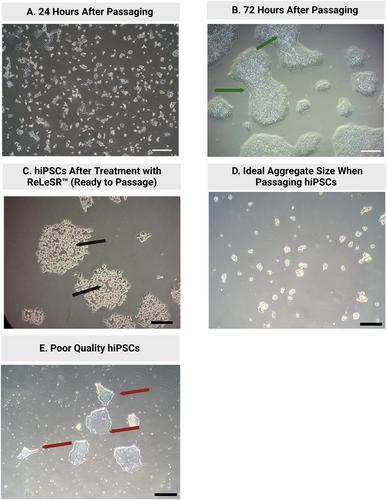Protocol for the Growth and Maturation of hiPSC-Derived Kidney Organoids using Mechanically Defined Hydrogels
Ivan Krupa, Niall J. Treacy, Shane Clerkin, Jessica L. Davis, Aline F. Miller, Alberto Saiani, Jacek K. Wychowaniec, Emmanuel G. Reynaud, Dermot F. Brougham, John Crean
下载PDF
{"title":"Protocol for the Growth and Maturation of hiPSC-Derived Kidney Organoids using Mechanically Defined Hydrogels","authors":"Ivan Krupa, Niall J. Treacy, Shane Clerkin, Jessica L. Davis, Aline F. Miller, Alberto Saiani, Jacek K. Wychowaniec, Emmanuel G. Reynaud, Dermot F. Brougham, John Crean","doi":"10.1002/cpz1.1096","DOIUrl":null,"url":null,"abstract":"<p>With recent advances in the reprogramming of somatic cells into induced Pluripotent Stem Cells (iPSCs), gene editing technologies, and protocols for the directed differentiation of stem cells into heterogeneous tissues, iPSC-derived kidney organoids have emerged as a useful means to study processes of renal development and disease. Considerable advances guided by knowledge of fundamental renal developmental signaling pathways have been made with the use of exogenous morphogens to generate more robust kidney-like tissues <i>in vitro</i>. However, both biochemical and biophysical microenvironmental cues are major influences on tissue development and self-organization. In the context of engineering the biophysical aspects of the microenvironment, the use of hydrogel extracellular scaffolds for organoid studies has been gaining interest. Two families of hydrogels have recently been the subject of significant attention: self-assembling peptide hydrogels (SAPHs), which are fully synthetic and chemically defined, and gelatin methacryloyl (GelMA) hydrogels, which are semi-synthetic. Both can be used as support matrices for growing kidney organoids. Based on our recently published work, we highlight methods describing the generation of human iPSC (hiPSC)-derived kidney organoids and their maturation within SAPHs and GelMA hydrogels. We also detail protocols required for the characterization of such organoids using immunofluorescence imaging. Together, these protocols should enable the user to grow hiPSC-derived kidney organoids within hydrogels of this kind and evaluate the effects that the biophysical microenvironment provided by the hydrogels has on kidney organoid maturation. © 2024 The Authors. Current Protocols published by Wiley Periodicals LLC.</p><p><b>Basic Protocol 1</b>: Directed differentiation of human induced pluripotent stem cells (hiPSCs) into kidney organoids and maturation within mechanically tunable self-assembling peptide hydrogels (SAPHs)</p><p><b>Alternate Protocol</b>: Encapsulation of day 9 nephron progenitor aggregates in gelatin methacryloyl (GelMA) hydrogels.</p><p><b>Support Protocol 1</b>: Human induced pluripotent stem cell (hiPSC) culture.</p><p><b>Support Protocol 2</b>: Organoid fixation with paraformaldehyde (PFA)</p><p><b>Basic Protocol 2</b>: Whole-mount immunofluorescence imaging of kidney organoids.</p><p><b>Basic Protocol 3</b>: Immunofluorescence of organoid cryosections</p>","PeriodicalId":93970,"journal":{"name":"Current protocols","volume":"4 7","pages":""},"PeriodicalIF":0.0000,"publicationDate":"2024-07-10","publicationTypes":"Journal Article","fieldsOfStudy":null,"isOpenAccess":false,"openAccessPdf":"https://onlinelibrary.wiley.com/doi/epdf/10.1002/cpz1.1096","citationCount":"0","resultStr":null,"platform":"Semanticscholar","paperid":null,"PeriodicalName":"Current protocols","FirstCategoryId":"1085","ListUrlMain":"https://onlinelibrary.wiley.com/doi/10.1002/cpz1.1096","RegionNum":0,"RegionCategory":null,"ArticlePicture":[],"TitleCN":null,"AbstractTextCN":null,"PMCID":null,"EPubDate":"","PubModel":"","JCR":"","JCRName":"","Score":null,"Total":0}
引用次数: 0
引用
批量引用
Abstract
With recent advances in the reprogramming of somatic cells into induced Pluripotent Stem Cells (iPSCs), gene editing technologies, and protocols for the directed differentiation of stem cells into heterogeneous tissues, iPSC-derived kidney organoids have emerged as a useful means to study processes of renal development and disease. Considerable advances guided by knowledge of fundamental renal developmental signaling pathways have been made with the use of exogenous morphogens to generate more robust kidney-like tissues in vitro . However, both biochemical and biophysical microenvironmental cues are major influences on tissue development and self-organization. In the context of engineering the biophysical aspects of the microenvironment, the use of hydrogel extracellular scaffolds for organoid studies has been gaining interest. Two families of hydrogels have recently been the subject of significant attention: self-assembling peptide hydrogels (SAPHs), which are fully synthetic and chemically defined, and gelatin methacryloyl (GelMA) hydrogels, which are semi-synthetic. Both can be used as support matrices for growing kidney organoids. Based on our recently published work, we highlight methods describing the generation of human iPSC (hiPSC)-derived kidney organoids and their maturation within SAPHs and GelMA hydrogels. We also detail protocols required for the characterization of such organoids using immunofluorescence imaging. Together, these protocols should enable the user to grow hiPSC-derived kidney organoids within hydrogels of this kind and evaluate the effects that the biophysical microenvironment provided by the hydrogels has on kidney organoid maturation. © 2024 The Authors. Current Protocols published by Wiley Periodicals LLC.
Basic Protocol 1 : Directed differentiation of human induced pluripotent stem cells (hiPSCs) into kidney organoids and maturation within mechanically tunable self-assembling peptide hydrogels (SAPHs)
Alternate Protocol : Encapsulation of day 9 nephron progenitor aggregates in gelatin methacryloyl (GelMA) hydrogels.
Support Protocol 1 : Human induced pluripotent stem cell (hiPSC) culture.
Support Protocol 2 : Organoid fixation with paraformaldehyde (PFA)
Basic Protocol 2 : Whole-mount immunofluorescence imaging of kidney organoids.
Basic Protocol 3 : Immunofluorescence of organoid cryosections
使用机械定义水凝胶生长和成熟 hiPSC 衍生肾脏有机体的方案。
随着体细胞重编程为诱导多能干细胞(iPSC)、基因编辑技术和干细胞定向分化为异质组织的方案的最新进展,iPSC 衍生的肾脏器官组织已成为研究肾脏发育和疾病过程的有用方法。在基本肾脏发育信号通路知识的指导下,利用外源性形态发生因子在体外生成更强大的肾脏样组织的技术取得了长足的进步。然而,生物化学和生物物理微环境线索对组织的发育和自组织具有重大影响。在微环境的生物物理工程方面,使用水凝胶细胞外支架进行类器官研究越来越受到关注。最近有两类水凝胶备受关注:一类是全合成和化学定义的自组装肽水凝胶(SAPHs),另一类是半合成的明胶甲基丙烯酰(GelMA)水凝胶。这两种水凝胶都可用作生长肾脏器官组织的支撑基质。根据我们最近发表的研究成果,我们重点介绍了人类 iPSC(hiPSC)衍生肾脏器官组织的生成方法,以及它们在 SAPHs 和 GelMA 水凝胶中的成熟过程。我们还详细介绍了利用免疫荧光成像表征此类器官组织所需的方案。总之,这些方案应能让用户在这类水凝胶中培育出源于hiPSC的肾脏器官组织,并评估水凝胶提供的生物物理微环境对肾脏器官组织成熟的影响。© 2024 作者。当前协议》由 Wiley Periodicals LLC 出版。基本方案 1:将人类诱导多能干细胞(hiPSCs)定向分化成肾脏类器官,并在机械可调自组装多肽水凝胶(SAPHs)中成熟:在明胶甲基丙烯酰(GelMA)水凝胶中封装第 9 天肾小球祖细胞聚集体。支持方案 1:人类诱导多能干细胞(hiPSC)培养。支持方案 2:用多聚甲醛(PFA)固定类器官 基本方案 2:肾脏类器官的整装免疫荧光成像。基本方案 3:类器官冷冻切片的免疫荧光。
本文章由计算机程序翻译,如有差异,请以英文原文为准。


